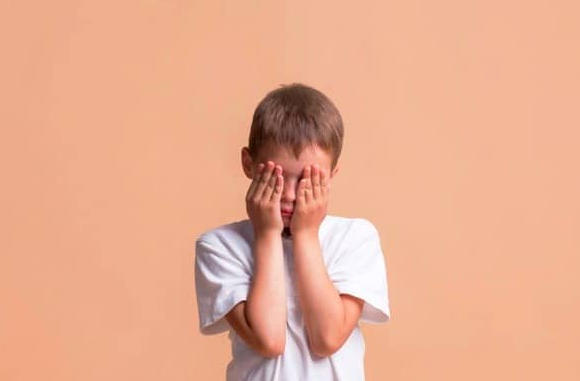Shy children’s problem and the best solutions
Children’s shyness is not a defect, but a moral trait that does not require parents to punish or embarrass them. Parental encouragement and support will improve this moral trait in children. Some societies consider being shy a behavioral advantage and like and praise it, and it is inherited by children.
Shyness is a personality trait that many children, teenagers, and adults possess. It is important to keep in mind that many adults were shy as children, so this issue should not lead to parental violence or shame in children, since this characteristic can be corrected with patience, encouragement, and support from their parents.
When greeting others, shy children hide behind their parents and stand silently without saying anything. Shy children can manage their shyness with just a little support from their parents.

Communicating with shy children:
In cognitive behavioral therapy, people are taught to face fearful situations so they can control them confidently.
Children need specific guidance on how to interact with peers in positive ways and do such things, not more rejection.
Don’t confront them, but work with them:
In order to fit in and be loved, shy children don’t have to become extroverted. There is definitely a place in the world for quieter styles! In order to lead positive reactions from others, they need to find ways to interact with who they are.
Consider the child’s interests:
Fun activities help children make friends. A child’s favorite activity can be a stepping stone to friendship. A child who is focused on fun activities has something to do and can talk about with his peers and is less worried about being alone or rejected.
Practice social cues:
Many of the things we say to others are routine and do not require clever witticisms. Through play, help the child learn simple social interactions. Greeting people with eye contact, a clear voice, and a friendly smile makes friends and attracts attention.
Engage your audience:
There are many shy children who feel more comfortable with a person. Playing and relaxing can help a shy child practice social skills and develop friendships. Children feel happier and less threatened when they have at least one friend who loves them. Be sure to tell the child how to behave before the guest arrives.
Take a look at things from someone else’s perspective:
Children may take years to develop this understanding of how people might feel in certain circumstances. When talking with your child about ideas and feelings in books, TV shows, or movies, you can very effectively support your point of view.
The process of labeling feelings and understanding inner experiences is enhanced when children talk about them. Children can benefit from putting themselves in others’ shoes. Focus on helping others feel comfortable, this can help shy children let go.

Don’t rush:
Children can take some time to overcome shyness. It may not be immediately apparent to peers that your child has turned a new leaf. The child can grow and learn if you believe in them. The child can communicate with other children with constant guidance and effort.
You can help the shy child by:
There are many children who are shy. You may decide that having a shy child is not such a bad thing if you understand what this phrase actually means. Depending on how shyness is handled, it can be a help or a hindrance to a child.
An embarrassment can help a child:
The trait of shyness is not a flaw, but a personality trait. Shy people have made some of the greatest contributions to the world. In addition to being sympathetic listeners, these people tend to exude a pleasant presence without even speaking.
Shyness is often misunderstood and considered a problem by many people. A shy child is thought to have a poor self-image. Often, this label is unfair, since many shy children understand the meaning of their actions.
An embarrassment obstacle:
Shyness in some children is the result of internal problems, not peace of mind. The child withdraws, avoids eye contact, and has behavioral problems. In his presence, people do not feel comfortable. Instead of operating out of peace and trust, this little person operates out of anger and fear. You often find that he is very angry as you dig deeper.
Shy children hide behind:
In order to avoid having to show themselves to people they don’t like, some children hide behind the label of a shy child. The label “shy” becomes an excuse not to develop social skills and an excuse not to use them.
Develop the child’s social skills by teaching him or her:
To overcome shyness, you can teach your child many social skills. Show him how to:
Getting to know new people
Get to know others by greeting them
Engage in conversation
Take part in the game
Engage in eye contact
Listen carefully
Describe the benefits of being social:
There is a good chance that you were shy as a child or that you may still be shy in certain situations.
Socialize and make friends with the child:
Introduce the child to new children and settings gradually. Do not force him to interact with unfamiliar children, spend a lot of time entertaining him when you visit a park where children play regularly.
Teach your child the words he needs to speak with new friends during the first interactions. Here are a few ways you can do it:
“Tell them you want to help them,” or “Ask what they are playing.”
Reward your progress by setting goals:
Establish behavioral goals with your child and track his progress. Build slowly from the ground up. Put a mark on the progress chart when your child meets a goal.
Social behavior should be praised:
Encourage the child to learn new social skills. Praise him with affection and warmth when he is trying to overcome shyness. The child may feel embarrassed if you do this in public. Tell him what he did privately instead.
Enhance the child’s self-esteem:
Shy children are less likely to feel good about themselves. Build on your child’s strengths. Does he have a creative side? How effective is exercise? When these skills are promoted, the child sees himself as talented and capable. As a result of this sense of confidence, he can become more courageous in social situations.
Getting in touch with teachers:
Attend preschool or kindergarten classes with the child. Make a plan to help your child overcome shyness. Communicate often with the teacher about the strategies you use at home, set the child’s goals together, and use a consistent approach both at home and at school to increase your results.


